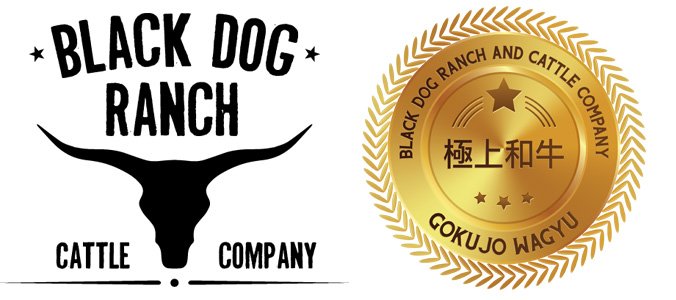American Wagyu
Wagyu is used to describe 4 breeds of Japanese cattle which came out of a Japanese government program to improve the breed. The purpose of the government program which went from around 1867 through 1911 was to improve the Japanese beef quality through crossbreeding Japanese cattle with non-Japanese cattle. The 4 Japanese breeds are Japanese Black (Kuroge Washu), Japanese Brown (Akage Washu or Akaushi), Japanese Polled (Mukaku Washu), and Japanese Shorthorn (Nihon Tankaku Washu). These breeds make up what is known as Wagyu, or ‘Japanese Cow.’ Wagyu cattle arguably produce the best quality beef in the world—a beef product that is tender and highly marbled—with a low melting point fat that “melts in your mouth”. Wagyu beef is also more healthy than beef from other breeds of cattle due to a higher ratio of monounsaturated fatty acid as compared to saturated fatty acid. Consumer demand for Wagyu beef is because of its marbling and high percentage of oleaginous unsaturated fat. Wagyu beef commands high prices because of the high quality of the meat and its marbling. Wagyu cattle’s unique genetics gives the beef a higher percentage of omega-e and omega-6 fatty acids than other beef. The result is higher prices and higher quality beef than available in other breeds of cattle.
Wagyu breeding outside of Japan is relatively new and the pool of genetics is small. The first Wagyu’s to be exported from Japan to the United States was in 1976. The first shipment consisted of 2 Black and 2 Red Wagyu Bulls and were sent to Colorado University for research and semen collection. All 4 bulls were fullblood Wagyu’s. After which the bulls were sold to private Wagyu Breeders Inc. The original Bulls exported to the US were:
Mazda, from Tottori, of the Kedaka line
Mt Fuji, from Hyogo, of the Tajima line
Rueshaw, from Kumamoto, a Red Wagyu of the Kumamoto Red line
Judo, from Kumamoto, a Red Wagyu of the Kumamoto Red line.
In 1976 Rueshaw (IMP JAP), one of the first two Wagyu bulls to be exported to the US was a ‘fullblood’ Akaushi bull and the Japanese Red National Champion Bull in 1975. He came from Kumamoto region of Japan which is considered the Akaushi breeding capital. Because cattle from this region are bred for development on grass they yield high degree of natural fleshing. It has been Rueshaw’s (IMP JAP) crossbred stock that opened the way for Wagyu in the United States.
No females were exported until 1993. Between 1976 and 1993 all Wagyu breeding in the US was ‘crossed’ with other breeds of cattle, primarily Angus. In 1993 the first females were exported from Japan along with 2 more bulls:
Suzutani, a female of the Tajima line
Rikitani, a female of the Tajima line
Okutani, a female that was 75% Tajima and 25% Fujiyoshi
Michifuku, a bull that was 94% Tajima
Haruki 2, a bull that was 56% Tajima and 19% Fujiyoshi
From 1994 through 1997 additional, though small amounts of Wagyu were exported to the US. These shipments added diversity to the US Wagyu gene pool by the addition of Shimane and Kedaka lines. This along with the Tajima line already in the US added to the milk, size, and marbling quality of the US Wagyu population. In 1997 the Japanese Government declared the Wagyu a national treasure and have banned the export of live animals and genetics. No additional Wagyu from Japan have come into the US. The primary lines exported from Japan are Tajima (Tajiri), Fujiyoshi (Shimane), and Kedaka (Tottori).
The Tajima line is from the Hyogo prefecture of which Kobe is the capitol. Cattle from this area were used to pull carts and plows so developed large forequarters and smaller hindquarters.
The Fujiyoshi line is from the Okayama prefecture and over time this strain has been introduced into other prefectures. Cattle from this region are medium framed with average growth rates. They offer qood maternal qualities and good fertility and good quality meat.
The Kedaka line is from the Tottori prefecture. Cattle from this region were used as pack animals and through selective breeding have developed strong straight backs and larger frames that other Wagu. Their meat is more variable than other Black Wagyu but have much higher milk quality than the others.
Red Wagyu are different than the three strains of Black Wagyu. They are referred to within Japan as “Japanese Brown”, and outside of Japan are also sometimes referred to as “Akaushi”. Red Wagyu are a red hided animal that originated in the southern part of Japan—primarily in the Kumamoto prefecture—which is located on the island of Kyushu in southwestern Japan, where range grazing is more popular than the confinement operations typical in other parts of Japan.
The Red Wagyu bloodline is believed to have evolved from ancient Asian breeds that on the Southeast Asian mainland evolved into the red Korean breeds such as the modern Korean Hanwoo. This bloodline was then influenced during the Japanese government led improvement program by crossbreeding with certain European breeds, including primarily the Simmental and Devon breeds.
The American Wagyu Association which was founded in 1990 has set the term “fullblood” to describe a Wagyu that is 100% descended from the genetics exported from Japan of the 4 breeds representing Wagyu - Japanese Black, Japanese Brown (Akaushi), Japanese Polled and Japanese Shorthorn. The term “Purebred” is used to define offspring resulting from breeding a “fullblood” with another breed and that offspring has been then bred up to a “fullblood.” At this 4th generation, the offspring is 15/16th or 93.75% Wagyu genetics and is registered as “purebred.”

